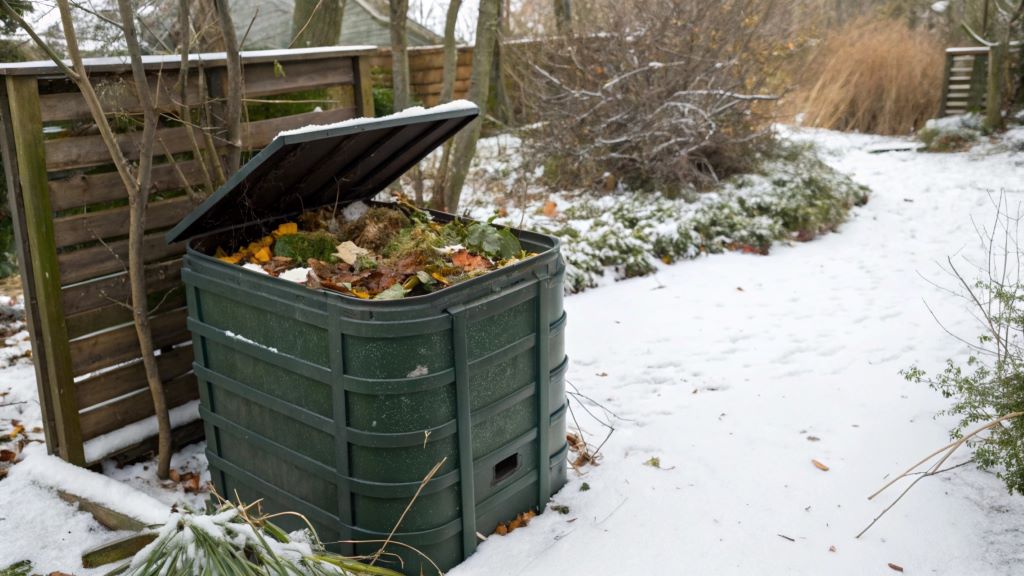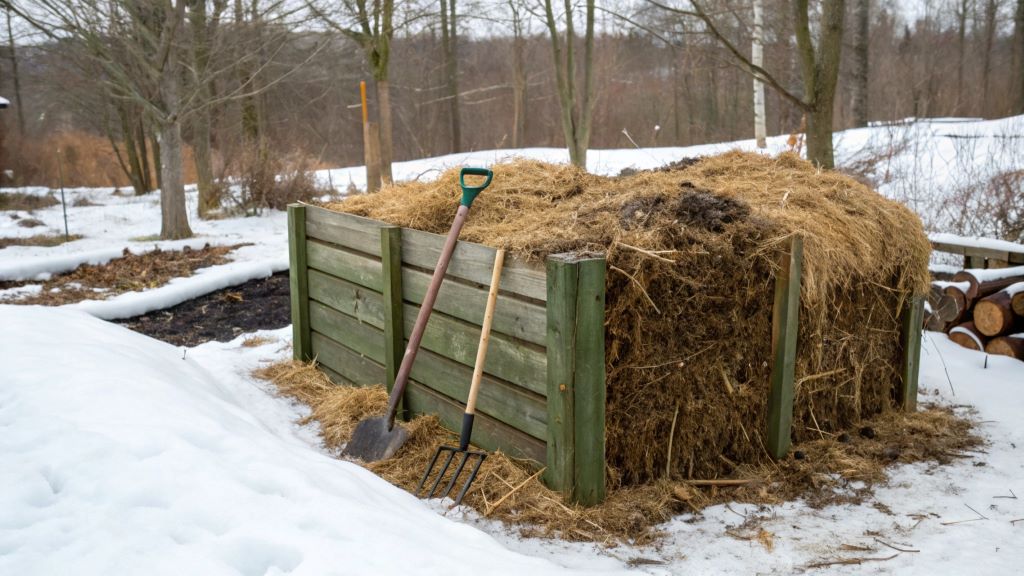
Composting in cold climates can feel like a daunting task, but it’s a rewarding way to reduce waste and enrich your soil. Growing up in a snowy Minnesota town, I watched my grandmother transform kitchen scraps into nutrient-rich compost despite freezing winters. Her garden thrived, and I learned that how to compost in cold climates is not only possible but also deeply satisfying. With the right approach, anyone can turn food scraps and yard waste into “black gold” for their garden, even when temperatures plummet. According to the Environmental Protection Agency, composting reduces landfill waste by up to 30%, making it an eco-friendly choice. This guide will walk you through practical steps to compost successfully in chilly regions, blending personal insights and expert advice to help you get started.
Why Composting in Cold Climates Matters
Composting in cold climates is more than just a gardening hack; it’s a commitment to sustainability. Cold weather slows decomposition, but with proper techniques, you can keep the process alive. The U.S. Department of Agriculture notes that composting diverts organic waste from landfills, cutting methane emissions by up to 50%. This is crucial in cold regions where waste management can be challenging.
Additionally, composting enriches soil, improving its structure and fertility. In my experience, using compost in our frozen backyard garden helped grow vibrant vegetables despite harsh winters. By composting, you’re not just helping your garden but also contributing to a healthier planet. Start small, and you’ll soon see the benefits of turning waste into a valuable resource.
Choosing the Right Composting System
Selecting a suitable composting system is key to success in cold climates. Options include tumblers, stationary bins, and worm composting. Tumblers are great for easy turning, which keeps the pile aerated, while stationary bins are budget-friendly. Vermicomposting, using worms, works well indoors during freezing months.
Consider your space and climate. For instance, insulated bins retain heat better, speeding up decomposition. When I started composting, I chose a tumbler for its convenience, and it made a big difference in managing the pile during snowstorms. Research from Cornell University suggests insulated systems can maintain microbial activity even at 20°F. Place your bin in a sunny, sheltered spot to maximize warmth, and ensure it’s accessible for regular maintenance.
What to Compost in Cold Weather
Knowing what to compost is critical for success. Stick to a mix of “greens” (nitrogen-rich materials like vegetable peels) and “browns” (carbon-rich materials like dry leaves). Aim for a 1:3 ratio of greens to browns to maintain balance.
- Greens: Fruit scraps, coffee grounds, grass clippings.
- Browns: Dry leaves, cardboard, straw.
Avoid meat, dairy, or oily foods, as they attract pests and slow decomposition. In my first winter composting, I made the mistake of adding cheese, which drew unwanted critters. Chopping materials into smaller pieces speeds up the process, especially in cold climates where microbes work slower. Regularly check your pile to ensure it’s not too wet or dry, adjusting with browns or greens as needed.
Maintaining Your Compost Pile in Winter

Cold weather slows microbial activity, but you can keep your pile active with a few tricks. Insulate your bin with straw, leaves, or even old blankets to trap heat. Turn the pile every few weeks to aerate it, ensuring oxygen reaches the microbes.
In my experience, layering the pile with extra browns during heavy snow helped maintain airflow. According to a study by the University of Minnesota, turning compost in winter can increase decomposition rates by 20%. If temperatures drop below 10°F, consider moving smaller bins indoors to a garage or basement. Monitor moisture levels; the pile should feel like a wrung-out sponge. Too much water can freeze, stalling the process, so cover your bin to protect it from snow.
Troubleshooting Common Cold-Climate Composting Issues
Composting in cold climates comes with challenges like frozen piles or slow decomposition. If your pile freezes, don’t panic—microbes will resume work when it thaws. To prevent freezing, insulate well and keep the pile large enough to generate heat (at least 3×3 feet).
Odors or pests indicate an imbalance. Too many greens can cause smells, so add more browns. In my early composting days, a smelly pile taught me to balance materials carefully. Secure lids tightly to deter animals. If decomposition is too slow, try adding a compost activator or coffee grounds to boost microbial activity. Regular monitoring and small adjustments will keep your compost thriving, even in the coldest months.
Indoor Composting as a Winter Solution
When outdoor composting becomes tough, indoor systems like vermicomposting offer a great alternative. Worms thrive in temperatures between 55°F and 77°F, making them ideal for cold climates. Set up a small bin with bedding like shredded newspaper and add food scraps gradually.
I tried vermicomposting one winter, and the worms turned my kitchen scraps into rich compost by spring. Ensure proper ventilation to avoid odors and keep the bin in a warm, dark place like a basement. The Rodale Institute reports that vermicomposting can produce compost 2–3 times faster than outdoor methods. It’s a practical solution for small spaces and ensures you keep composting year-round.
Benefits of Composting Year-Round
Composting in cold climates offers long-term rewards. It reduces waste, enriches soil, and supports sustainable gardening. The compost you create improves soil drainage and fertility, helping plants withstand harsh winters. In my garden, compost helped my tomatoes thrive despite frosty springs.
Moreover, composting fosters a sense of connection to the environment. Knowing your food scraps nourish the soil feels empowering. It’s also cost-effective, saving money on fertilizers. The Environmental Protection Agency states that compost can increase crop yields by up to 20%. By composting consistently, you’re building healthier soil and contributing to a greener future, no matter the season.
Conclusion
Composting in cold climates is a journey worth taking. From choosing the right system to troubleshooting issues, each step brings you closer to creating nutrient-rich compost. My grandmother’s garden taught me that with patience and care, even the coldest winters can’t stop a thriving compost pile. By composting, you reduce waste, enrich your soil, and contribute to a healthier planet. Start small, experiment, and soon you’ll see the fruits of your efforts. Ready to begin? Share your composting tips or questions in the comments below, or spread the word by sharing this article with fellow gardeners!
FAQs
How do I start composting in cold climates?
Choose an insulated bin or tumbler, place it in a sunny spot, and balance greens and browns. Turn regularly to maintain airflow.
Can I compost indoors during winter?
Yes, vermicomposting is ideal. Use a small bin with worms, keep it warm, and add scraps gradually to avoid odors.
What should I avoid composting in cold weather?
Avoid meat, dairy, or oily foods, as they attract pests and slow decomposition in cold climates.
How do I keep my compost pile from freezing?
Insulate with straw or blankets, keep the pile large, and cover it to protect from snow and moisture.
How long does composting take in cold climates?
It can take 6–12 months, depending on insulation, turning frequency, and material balance. Indoor systems may be faster.
Read More:





